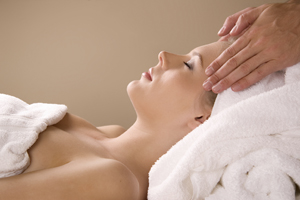by Linda Leibl —
We all want it, but how many of us actually know how to get healthy, glowing, radiant skin? The following four questions will help you find the answers to some of your most important skin care concerns.
Question #1: Why do I break out after a facial treatment and how can I prevent it?
Answer: First of all, find safe and healthy facials by asking your friends where they go and which treatments have given them the best results. An experienced aesthetician will use the correct implements and gentle extraction techniques to properly prepare the skin. Pimples and breakouts may occur occasionally from reactions to the products used in a treatment, so ask beforehand what they are using, especially if you know which ones irritate your skin.
Inflammation can occur during the treatment and may cause swelling of the follicle wall, which can then prevent oxygen from reaching the bottom of the follicle. Acneic bacteria thrive in an environment void of oxygen.
A soothing masque for balancing or hydration should be applied specifically for your skin type. A “super-plumping” masque is an excellent choice if your skin is dry or if you are older than 45 years. Super-hydrating masques can work like magic to improve your skin’s overall appearance.
Always avoid highly fragranced products and excessive massaging of the skin, as well as overly aggressive extractions — especially if you have thin or sensitive skin or are pregnant.
Question #2: Are 100 percent all-natural products chemical-free, and what about parabens in products?
Answer: According to Skin, Inc. magazine, “Nothing is chemical-free. Everything, including plant extracts, skin care products and even the human body is made up of chemicals. Without chemicals, people could not move, think or live. Natural substances can contain hundreds of chemicals that are naturally present, and one-third of all prescription drugs are made from plant sources.”
Parabens are esters of p-Hydroxybenzoic acid. They are used as safe, effective preservatives in cosmetic, food and drug formulations to protect against yeast, molds and bacteria.
When companies formulate skin care lines, the top priorities for these often-complex formulations are safety, purity and effectiveness. Preservatives are essential in maintaining the integrity of these formulations, and prestigious companies formulate with a “broad spectrum” preservative system to protect against oxidation, as well as contamination.
When formulating with both oil- and water-based ingredients, two types of preservative systems must be used in order to ensure long-term safety. Antioxidants, commonly known as natural preservatives, protect oils from oxidizing and going rancid.
For the most part, parabens are nonirritating and nonsensitizing for those with normal skin and are safe for use in cosmetic formulations, as outlined by the governing institutions, the FDA, the Personal Care Products Council and the Cosmetic Ingredient Review Board (CIR). However, paraben sensitization has been reported when paraben-containing medical applications have been applied to broken skin or when used in concentrations exceeding 1 percent.
Prestigious skin care companies use less than 0.5 percent, and you can always ask what percentages are used.
Question #3: Will mineral oil clog my pores?
Answer: It can, depending on the level of refinement, as well as which other ingredients it may be combined with. Mineral oil also can be defined as a comedogenic, which means it can clog your pores and induce acne lesions or comedones (blackheads).
Mineral oil is simply not beneficial for daily skin care use and can be disruptive to normal skin function when applied in high concentrations.
Mineral oil also is an inexpensive base that many skin care companies use in their formulations, because it rarely causes allergic reactions and is, for the most part, harmless when used for intended purposes.
Question #4: What about the use of sodium laureth sulfate in my products?
Answer: These ingredients are coconut-based surfactants and foam boosters used in such products as crèmes, lotions, cleansers, shampoos and toothpaste. Surfactants, as the name refers, remove dirt and oils from the surface of the skin and/or hair, which is the essential function of a cleanser.
These ingredients are not injurious when formulated properly, and they have not been found to be carcinogenic. In fact, the CIR has found that sodium laureth sulfate is safe when applied in concentrations of 36 percent or less. This review board concluded that sulfates like these are safe in formulations designed for brief use, such as with wash-off products.
For more information, see these Web sites: www.cir-safety.org, www.personalcarecouncil.org, www.fda.gov and www.arbonne.com.
References: Arbonne International, Skin, Inc. magazine
Linda L. Leibl, B.S., therapeutic aesthetician, founded Advanced Skin Technology in 1993. 480-443-3445 or LindaL@myarbonne.com.
Reprinted from AzNetNews, Volume 29, Number 2, Apr/May 2010.






February 27, 2012
Aesthetic procedures, Health, Inflammation, Skin